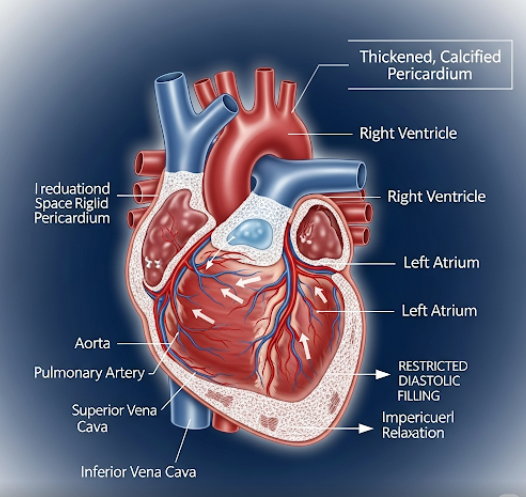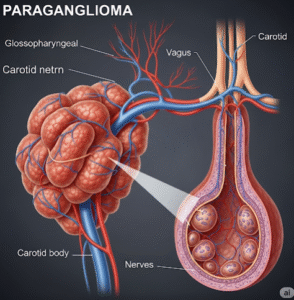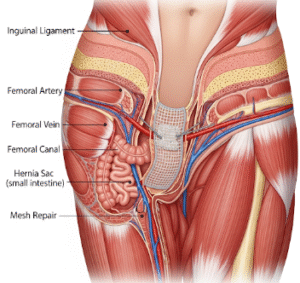Overview
Constrictive pericarditis is a chronic condition where the pericardium—the double-layered sac surrounding the heart—becomes thickened, scarred, and rigid, losing its normal elasticity. This prevents the heart from expanding properly during filling, leading to reduced cardiac output, fluid buildup in the body, and symptoms that mimic heart failure. Though rare, this condition can be life-altering or life-threatening without proper diagnosis and treatment.
What is Constrictive Pericarditis?
In a healthy heart, the pericardium allows the heart to move and expand as it beats. In constrictive pericarditis, the pericardial layers become fibrotic and calcified, restricting the heart’s ability to fill with blood between beats. This causes blood to back up in the lungs, liver, and abdomen, leading to congestive symptoms.
It typically develops as a late complication of chronic pericarditis, and may take months or years to manifest.
Symptoms
Symptoms of constrictive pericarditis can resemble heart failure or liver disease and often include:
- Shortness of breath, especially with exertion
- Swelling (edema) in the legs, ankles, or abdomen
- Fatigue and weakness
- Distended neck veins (JVD)
- Ascites (fluid in the abdomen)
- Weight gain from fluid retention
- Chest discomfort or pressure (less common than in acute pericarditis)
- Hepatomegaly (enlarged liver) or liver tenderness
Symptoms may be worsened by lying down and relieved slightly by sitting up or leaning forward.
Causes
Constrictive pericarditis is usually the result of long-term inflammation or damage to the pericardium. Causes include:
- Prior pericarditis, especially if untreated or recurrent
- Tuberculosis (a major cause in developing countries)
- Viral or bacterial infections
- Radiation therapy to the chest (e.g., for breast or lung cancer)
- Heart surgery or trauma
- Autoimmune diseases such as lupus or rheumatoid arthritis
- Cancer spreading to the pericardium
- Idiopathic (unknown causes)—in many cases, no exact cause is found
Risk Factors
Certain individuals are at greater risk for developing constrictive pericarditis:
- History of pericardial inflammation or effusion
- Previous chest radiation or cardiac surgery
- Chronic infections, particularly tuberculosis
- Autoimmune or connective tissue disorders
- Long-term kidney disease or dialysis patients
- Men over 40 years old (slightly higher incidence)
Complications
Without treatment, constrictive pericarditis can lead to serious health issues:
- Chronic right-sided heart failure
- Liver congestion or cirrhosis
- Kidney dysfunction due to reduced perfusion
- Arrhythmias (irregular heartbeats)
- Low cardiac output syndrome
- Cachexia (severe weight loss) in advanced stages
In severe cases, the heart may become unable to supply sufficient blood to the body’s organs.
Prevention
Preventing constrictive pericarditis involves early recognition and treatment of its root causes:
- Prompt treatment of acute pericarditis with anti-inflammatory medications
- Early management of tuberculosis or other infections
- Minimizing radiation exposure when treating chest cancers
- Regular follow-up after heart surgery or chest trauma
- Monitoring autoimmune disease activity
- Avoiding unnecessary pericardial interventions (when possible)
Regular medical evaluations are important for individuals at high risk.
Treatment Options in Korea
South Korea provides world-class cardiac care, with advanced diagnostics and surgical options for constrictive pericarditis.
Diagnosis:
- Echocardiography: Initial tool to assess heart motion and pericardial thickness
- CT or MRI scans: Provide detailed imaging of pericardial calcification or thickening
- Cardiac catheterization: Confirms diagnosis by measuring pressures in the heart chambers
- Chest X-ray: May show pericardial calcifications or an enlarged heart shadow
- Blood tests: To identify infections or autoimmune causes
Medical Management (for early or mild cases):
- Diuretics: To reduce fluid overload and swelling
- NSAIDs or corticosteroids: For inflammatory causes
- Colchicine or immunosuppressants if linked to autoimmune conditions
- Anti-tubercular treatment, if tuberculosis is the cause
Surgical Treatment (Definitive Solution):
- Pericardiectomy: Surgical removal of the thickened pericardium
- Offers symptom relief and improved survival
- Requires experienced cardiac surgeons
- Full recovery may take weeks to months, depending on disease severity
Top Hospitals in Korea:
South Korea’s leading centers such as Asan Medical Center, Seoul National University Hospital, Samsung Medical Center, and Yonsei Severance Hospital are renowned for advanced cardiac imaging, minimally invasive surgery, and postoperative rehabilitation. International patients have access to multilingual support and concierge medical services.













